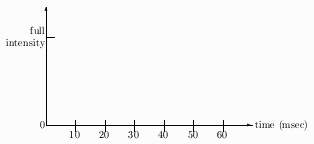| Your name, legible ______________________________ |
| Physics 102 |
| Due Tuesday, Sept 17 |
Since the Honor Pledge is required on all assignments, all the homework in this course will be considered a single assignment, and you are asked to sign the following pledge to cover this and all future homework in this course:
"I pledge on my honor that I have not given or received any unauthorized
assistance on this assignment/examination."
| your signature _____________________________ |
To enable you to gauge your progress, grades will frequently be posted on the WWW. Please supply a code word for yourself that can be used in posting grades:
| code word:_________________________ |
Problems: (answer on this sheet)
1. According to its schedule, a Shuttle-UM bus runs perfectly regularly from Lot HH to the College Park Metro Station and back, taking 24 minutes to complete a round trip.
- Is this motion periodic?
- Is the motion sinusoidal? If not, what standard wave (text, p. 10) would more nearly describe the motion? Assume - unrealistically - the shuttle moves at a uniform speed and is not held up by traffic lights.
- What is the period, in seconds?
- What is the frequency, in Hertz? (use "scientific notation", that is, 10 to a suitable power, to express this rather small number)
2. There is actually more than one bus running on the Shuttle-UM route
- Suppose a second bus leaves lot HH 12 minutes after the first one. What is the phase relationship between the motions of the two buses?
- The actual schedule shows the next bus leaving 8 minutes after the first one. What is the phase difference (in degrees) between the two?
3. Flashes of light are produced by placing a light source behind a fan. The fan has four blades rotating at 500 rpm, which "chop" the light.

- What is the frequency with which the light is being "chopped"?
- At right, plot the light intensity emerging from the fan versus time.
4. a. Below the graph of problem 3, draw a graph of motion that decreases in both frequency and amplitude as time progresses:
b. Is this damped harmonic motion? Why or why not?
5. Circle the letter of the phenomenon described below if it is
an example of resonance:
- A cork bobbing up and down in waves in the water
- Grandpa rocking in his favorite rockin chair
- A singer hitting a high note and shattering a glass
- People at a rock concert stomping their feet in rythm with the music
- Floor of auditorium vibrating and cracking due to stomping of audience in d.
- A rattle in your car that occurs while idling but stops as the motor increases speed.

